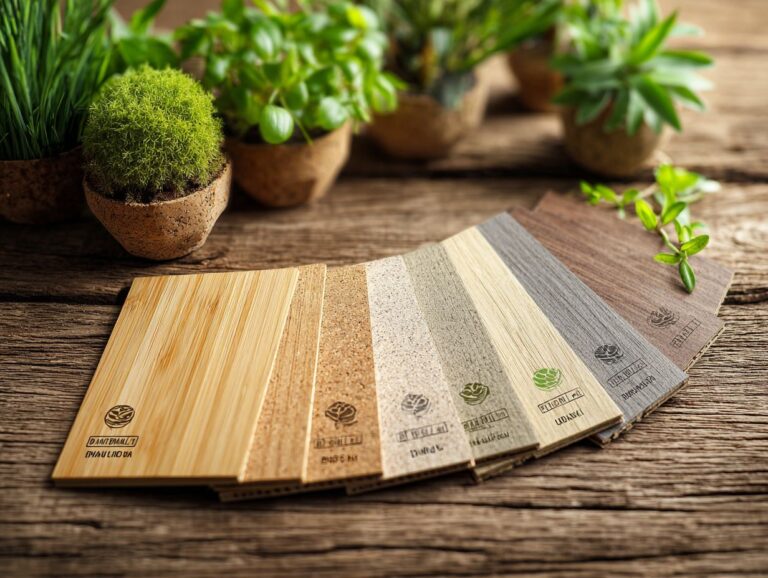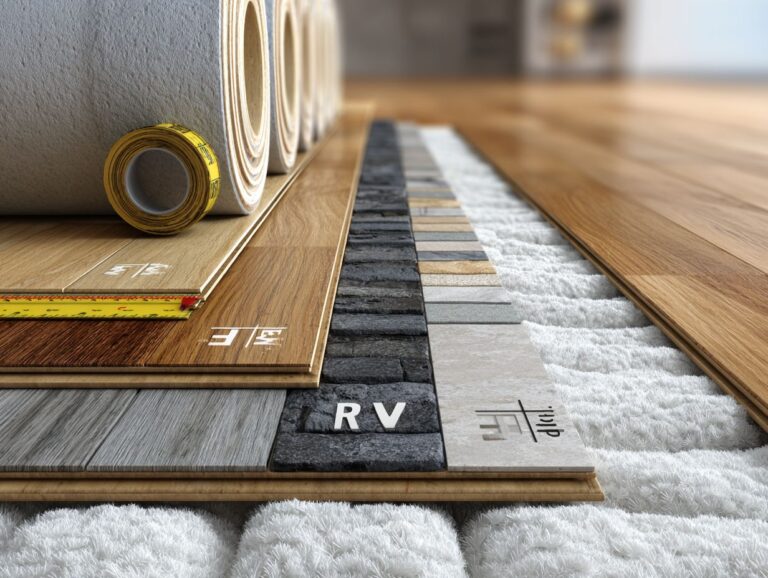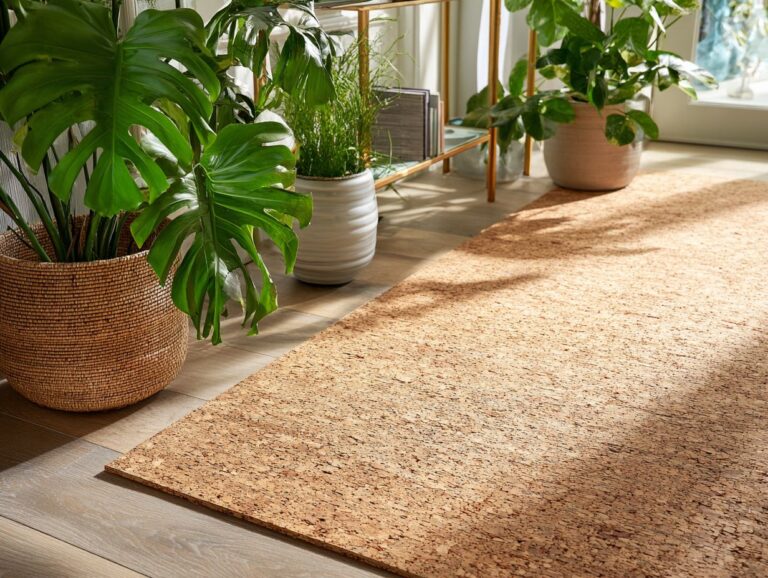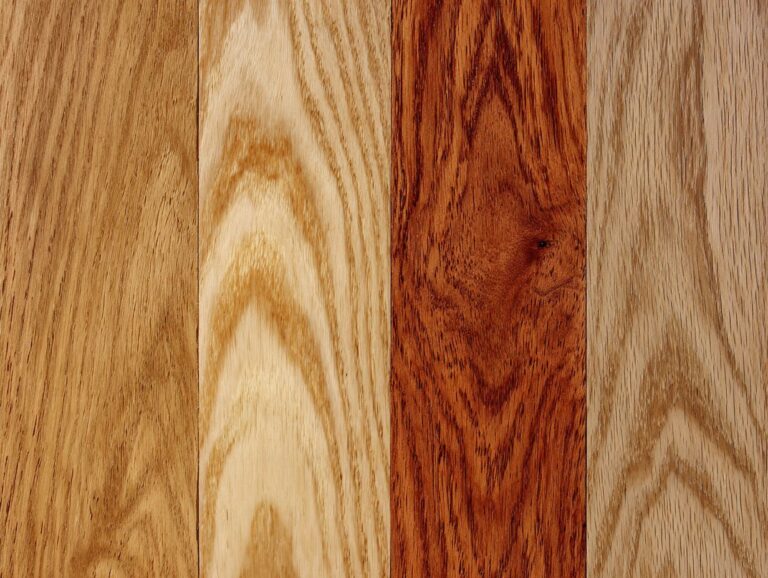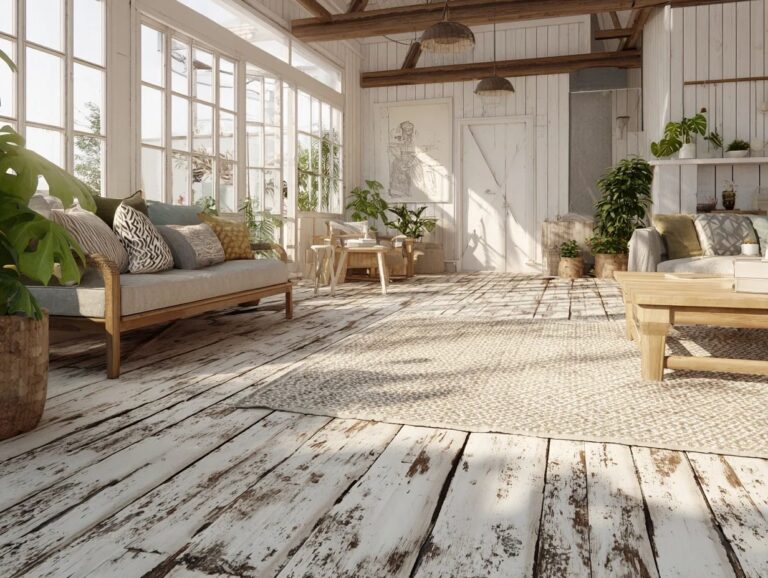Pool House and Changing Room Flooring Solutions
Contents
- Introduction to Pool House and Changing Room Flooring
- Types of Flooring Materials
- Pool House Flooring Trends
- Durability and Maintenance
- Design Considerations
- Installation Options
- Safety Features
- Frequently Asked Questions
- 1. What are some important factors to consider when choosing pool house and changing room flooring solutions?
- 2. Are there specific flooring options that are best suited for pool house and changing room environments?
- 3. How do I maintain and clean pool house and changing room flooring?
- 4. Is it necessary to have slip-resistant flooring in a pool house or changing room?
- 5. Can I use hardwood or carpet for pool house and changing room flooring?
- 6. Are there eco-friendly options for pool house and changing room flooring solutions?
Introduction to Pool House and Changing Room Flooring
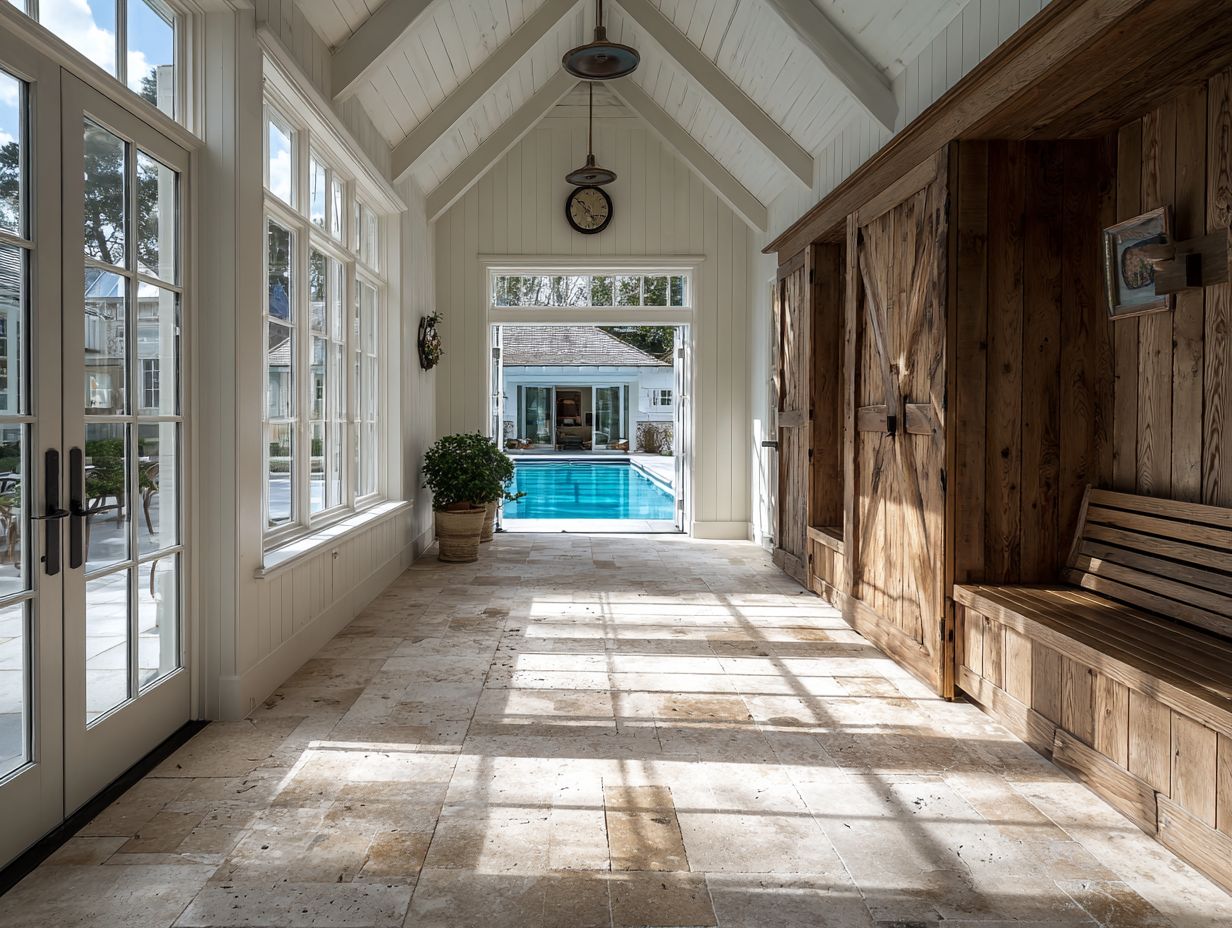
Key Takeaways:
Importance of Choosing the Right Flooring
Choosing appropriate flooring can reduce maintenance hassles and increase safety, with the right materials minimizing slip-and-fall accidents by 50%.
For example, Rubbaflex FG flooring at Larkfield Leisure Centre has significantly lessened cleaning time due to its non-porous surface. This flooring provides great grip and is easy to clean, needing just a quick mop instead of hard scrubbing.
Buildings that choose materials like rubber or vinyl usually have lower expenses over time. These surfaces last longer, which means they need to be replaced less often. Utilizing these specific materials can lead to substantial improvements in both safety and operational efficiency. For residential applications of durable flooring, our comprehensive guide on epoxy flooring systems offers valuable insights for homeowners looking to enhance their spaces.
Factors to Consider for Poolside Areas
Key factors like chlorine resistance and moisture exposure make specific materials more suitable for poolside environments, enhancing safety and durability.
Materials such as Stonex Quartz Screed offer excellent performance against these elements, ensuring long-lasting results.
Consider using non-slip tiles or textured concrete surfaces to further improve safety around the pool area.
Regular maintenance, like sealing joints and inspecting for cracks, can prevent water infiltration that compromises material integrity. It’s also advisable to opt for UV-resistant coatings on surfaces exposed to sunlight.
Together, these strategies create a safer, more durable poolside environment.
Types of Flooring Materials
Different types of flooring are suited for pool and changing rooms, offering a mix of looks and practical uses, especially when considering their waterproof and slip-resistant properties (our Bathroom Flooring Guide provides valuable insights into these features).
Pool House Flooring Trends
Pool House Flooring Trends
Key Flooring Trends: Luxury Vinyl Plank (LVP) Flooring
Key Flooring Trends: Patterned Tile Preference
The data on Pool House Flooring Trends Shows present customer choices and market trends for luxury vinyl plank (LVP) and patterned tile flooring. These materials are increasingly popular for their aesthetic appeal and functionality in pool houses, which require durable and moisture-resistant flooring solutions.
Luxury Vinyl Plank (LVP) Flooring is becoming popular because it lasts a long time and looks like real wood, which attracts homeowners looking for both style and functionality. With 82% of users satisfied with LVP’s durability, it is evident that consumers appreciate its ability to withstand moisture, scratches, and heavy foot traffic, which are common in pool house environments. The LVP market is projected to grow by 15.3% in 2024 This shows a strong need for budget-friendly and easy-to-care-for flooring choices, popular among homeowners and designers.
Patterned Tile Preference shows a shift towards distinct and custom floor designs. 58% of consumers prefer patterned tiles for their ability to add visual interest and a custom look to pool houses. However, the preference for detailed designs comes with a 10% increase in installation costs, reflecting the complexity and time required to install such tiles. Despite the higher costs, patterned tiles remain popular for their aesthetic value and durability, often perceived as a worthwhile investment for enhancing the appeal of a pool house.
In summary, Pool House Flooring Trends show a clear consumer inclination towards materials that combine durability with stylish design options. LVP’s growth is driven by its functionality and affordability, while patterned tiles are chosen for their distinctive aesthetic, even at a higher cost. These trends show that consumers want custom, durable flooring for pool houses that improves leisure and entertainment experiences.
Tile Flooring
Tile floors are sturdy and come in many styles, which is why they’re a popular option for places that get wet or require cleaning with chemicals.
Along with being long-lasting, tile flooring naturally prevents slipping, which makes it safe for bathrooms and kitchens.
Popular brands like Mohawk and Daltile offer options specifically designed for high-moisture environments, such as their textured porcelain tiles, which mimic hardwood aesthetics while providing excellent grip.
When choosing tile, consider the PEI rating, which indicates the tile’s durability; a rating of 4 or 5 is ideal for areas with heavy foot traffic. Combine this with proper sealing practices to make it last longer and resist moisture.
Vinyl Flooring
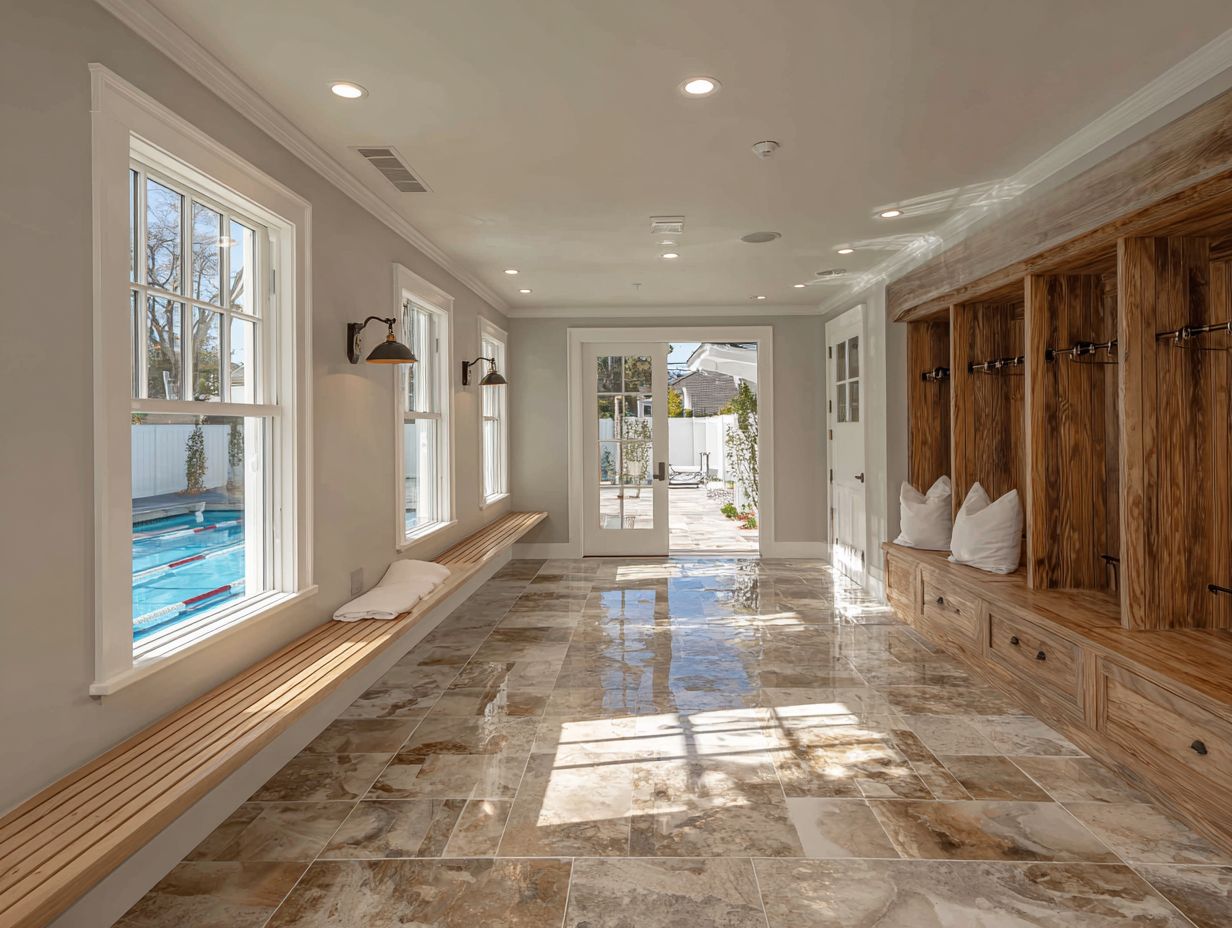
Vinyl flooring is an eco-friendly option that combines water resistance with low maintenance, ideal for poolside and changing room applications.
Its low porosity prevents water from seeping in, greatly reducing the growth of mold and mildew.
Popular products like Mohawk’s Recyclable Vinyl and Shaw’s Eco-friendly options provide durability and use recycled materials, demonstrating their focus on sustainability.
Cleaning is a breeze; a simple damp mop with a mild cleaner keeps the surface looking fresh.
Many vinyl options are designed to mimic natural materials, providing aesthetic appeal without sacrificing practicality.
Wood Flooring
While aesthetically pleasing, wood flooring can be challenging in high-moisture areas, requiring specific treatments to withstand wear and tear.
To make it last longer, think about using a good water-resistant coating like an outdoor-grade polyurethane. This can guard against water and spills.
Regular cleaning is important; use a damp mop instead of a wet one to prevent water damage, and quickly clean up spills to reduce moisture.
Integrating area rugs in poolside spaces can minimize water contact. With proper treatment and vigilant care, wood flooring can retain its beauty while enduring the unique challenges of a pool environment.
Concrete Flooring
Concrete flooring provides a seamless surface that’s highly durable but requires professional installation for the best results in poolside areas.
Concrete floors are tough and water-resistant, so they work well near pools and won’t be harmed by mold. To get the most out of these benefits, hire an installer who knows how to seal surfaces properly to prevent slipping and keep things safe.
Selecting a textured finish can improve grip and appearance. Long-term, proper maintenance involves occasional resealing and cleaning with mild detergents, helping your concrete floor last for years with minimal effort.
Carpet Tiles
Carpet tiles provide comfort and a clean surface. However, choose them carefully to make sure they are suitable for wet areas.
In changing rooms, moisture-resistant carpet tiles such as Interface’s ‘Human Nature’ collection or Mohawk’s ‘Air.o’ line are ideal choices.
These tiles are designed to resist mold and mildew, ensuring they remain fresh and clean despite exposure to water. Their modular design allows for easy replacement of individual tiles if damage occurs.
When installing, choose an adhesive setup that supports drainage and ventilation to improve long-lasting strength. This combination of comfort and functionality makes them a perfect fit for high-moisture areas.
Durability and Maintenance
When choosing flooring for areas around pools and changing rooms, it’s important to focus on how long it will last and how easy it is to keep clean.
Water Resistance
Waterproof flooring is important in areas prone to moisture. Materials with low porosity prevent water damage and last longer.
Rubbaflex FG stands out as an effective water-resistant flooring option, with a seamless design that prevents water infiltration. The low porosity makes it easy to clean, which cuts down on maintenance time and expenses.
Consider materials like vinyl and porcelain tiles; both provide excellent durability and resist mold growth. When selecting flooring, prioritize surfaces that can withstand humidity and frequent cleaning, ensuring longevity even in the most challenging environments.
Picking a low porosity choice can greatly improve the strength and look of your space.
Slip Resistance
Slip resistance is an important safety feature. The right flooring can decrease slip-and-fall accidents in changing rooms and pool areas by up to 60%.
To make floors less slippery, think about using materials like textured tiles, which offer grip even when wet, or rubber flooring, known for its good traction and comfort.
Textured porcelain tiles usually have a friction rating higher than 0.6, which makes them suitable for wet areas. Installing non-slip vinyl can create a softer surface that reduces the risk of falls.
According to the National Safety Council, around 9 million slip-and-fall accidents occur annually – investing in the right flooring can significantly mitigate this risk.
Ease of Cleaning
Floors that are simple to clean help keep areas clean, which is important for places with a lot of people walking through and where there is a lot of moisture.
For optimal hygiene, consider using materials like vinyl, which resists mold and mildew while being easy to scrub down.
Adding slip-resistant tiles can make floors safer. Using effective methods, like mopping often with disinfectants and setting up a cleaning plan, is important.
Clean busy areas daily to stop dirt from building up and keep the air clean.
Adding floor drains can make cleaning easier in changing rooms and pool areas by allowing water to be removed quickly, which helps prevent standing water.
Design Considerations
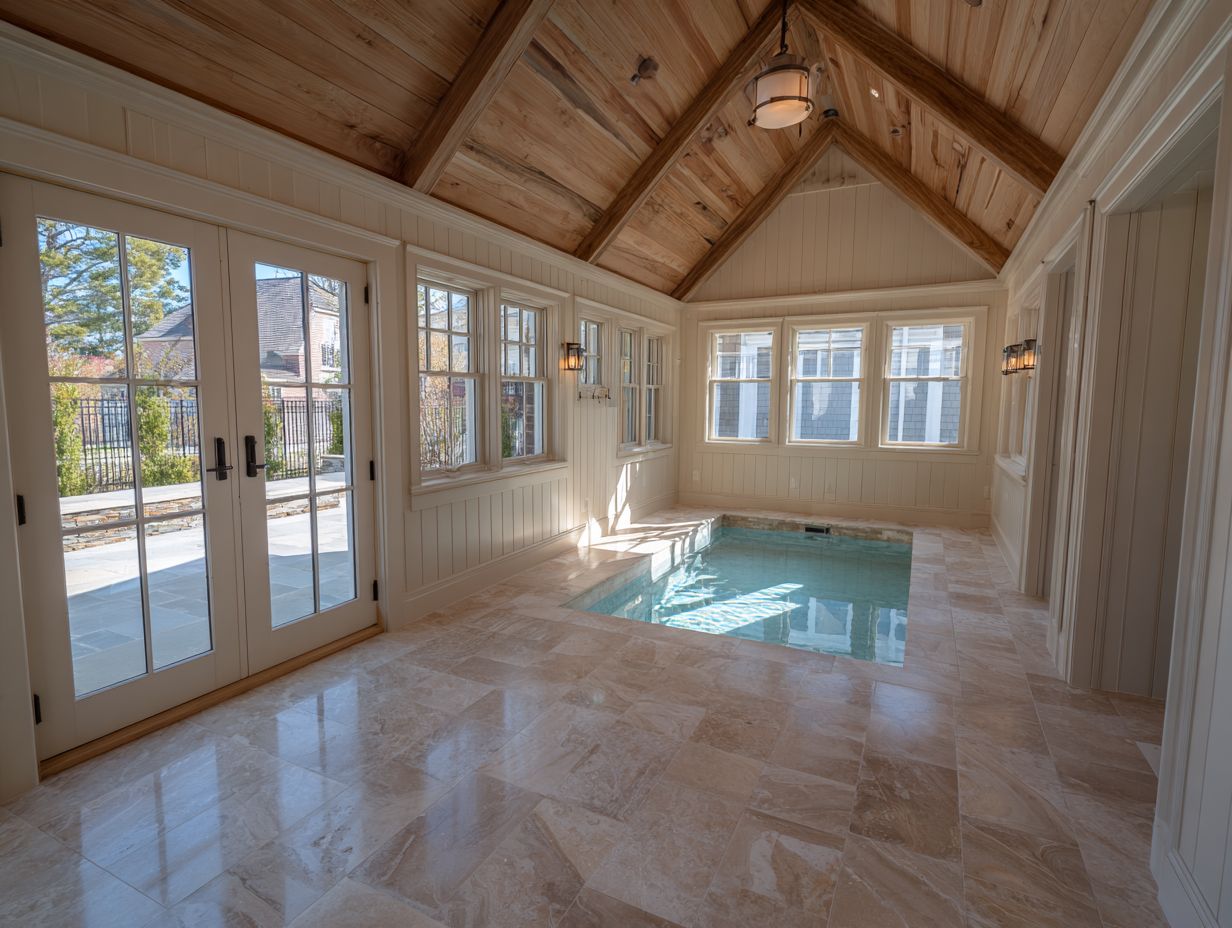
Choosing flooring is important for matching the look of poolside areas and changing rooms.
Color and Aesthetic Choices
Picking the right color and style can improve the atmosphere of a place, affecting how users feel and their level of satisfaction.
Colors can create various feelings, so choosing the right ones is important for places like pools and changing rooms.
For example, soft blues can help create a peaceful feeling, perfect for designing a relaxed pool setting. When paired with light-toned wood laminate flooring, this scheme promotes relaxation.
On the other hand, bright oranges and yellows can make spaces feel lively, pairing nicely with modern grey tile flooring, and promoting activity and socializing.
Using color psychology improves the look and makes users feel better, which can lead to them visiting the facility again.
Texture and Finish Options
Different textures and finishes can improve both how flooring works and how it looks in places used for relaxation and fun.
For example, textured vinyl flooring prevents slipping and is simple to clean, which makes it a good choice for busy places like gyms or pools.
Meanwhile, polished concrete can be treated with anti-slip finishes that provide both safety and a modern look.
Wood-look laminate products often feature embossed surfaces that mimic the natural grain, lending character without sacrificing durability.
When choosing a finish, think about coatings such as urethane that resist moisture, as they can greatly improve comfort and safety for users.
Integration with Pool Design
Choosing the right flooring to match pool design makes the area look unified and improves safety for users.
To achieve this integration, consider the pool’s overall aesthetics and functionality. Use slip-resistant materials like textured porcelain tiles or treated wood that complement the pool’s color palette.
Work with construction and outdoor space experts from the start to make sure the flooring smoothly connects the pool area with nearby places. Regularly assess maintenance needs as well; for instance, choosing lighter-colored finishes may require more frequent cleaning.
Choose flooring that looks good, is safe, and lasts long around the pool.
Installation Options
Deciding between doing it yourself or hiring a professional can significantly impact the price and quality of flooring in business spaces.
DIY Installation vs. Professional Help
While doing it yourself can be cheaper, hiring an expert makes sure the job is done correctly and helps prevent problems in high-traffic areas.
For example, a DIY installation may cost around $300 for materials, but if you lack experience, you could end up spending an additional $150 on repairs.
Conversely, professional installation typically ranges from $500 to $800, offering warranties and expert guidance.
If you’re fitting flooring in a living room versus a busy restaurant, the latter would greatly benefit from hiring a professional to guarantee durability and safety.
Weigh your budget against the project’s complexity to determine the best approach.
Preparation of the Subfloor
Proper subfloor preparation is essential for a seamless surface and long-lasting flooring performance, impacting overall user safety.
- Start by checking for substrate movement; any signs of movement should be addressed before proceeding.
- Next, use a self-leveling compound to even out the surface. Be sure to fill any holes to prevent problems later.
- Remember to use a moisture meter to check if the subfloor is dry enough for the flooring you want to install.
- Following these best practices-like allowing sufficient drying time for leveling compounds-will help achieve a durable flooring installation.
Cost Factors in Installation
Knowing the expenses of putting in new flooring helps you budget and guarantees the flooring is durable and of good quality.
Key components to consider include material choice, installation methods, and maintenance.
Laminate flooring usually costs between $1 and $5 per square foot, offering an affordable choice. On the other hand, hardwood flooring prices range from $8 to $15. If you opt for professional installation, expect to pay about $2 to $6 per square foot, depending on labor rates in your area.
Think about the expenses involved in maintaining your choices over time. For example, tile is easy to keep clean, but hardwood might need to be refinished, adding to your later expenses.
Safety Features
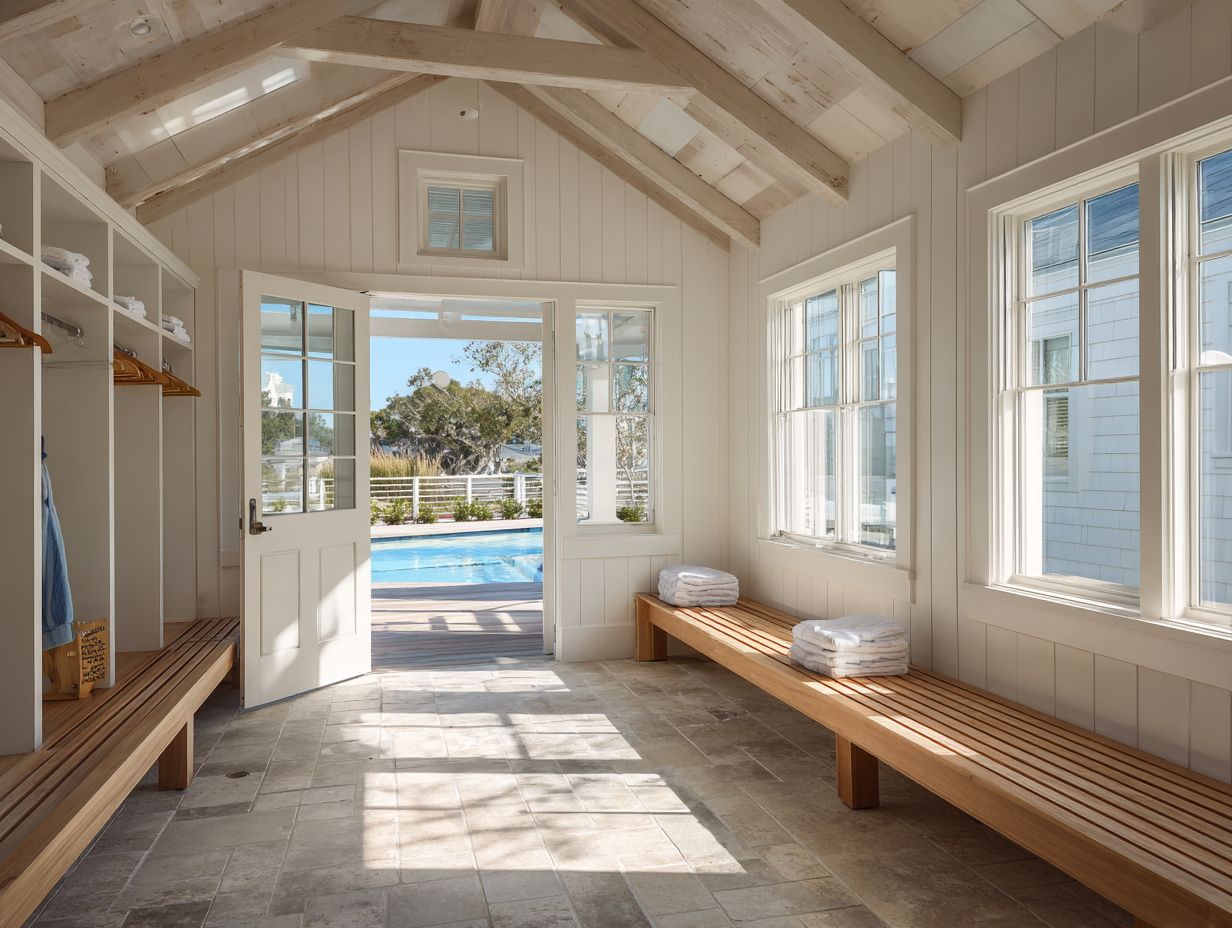
Safety features are essential in flooring for changing rooms and pool areas to protect users from possible injuries.
Non-Slip Options
Floors with a non-slip surface can greatly lower the chance of slipping and falling, which is important for areas that frequently get wet.
When evaluating flooring materials for slip resistance, look for the coefficient of friction (COF) rating. A COF of 0.6 or higher is recommended for commercial areas.
Consider options like:
- Textured vinyl
- Slip-resistant ceramic tiles
- Rubber flooring
These options all provide excellent traction. Make sure to keep up with maintenance, as surfaces can become slippery over time. Putting non-slip coatings or mats in areas where falls are likely can improve safety. Regularly inspect these solutions to guarantee their effectiveness, particularly in busy settings like kitchens or bathrooms.
Impact Resistance
Flooring that resists impact helps prevent injuries and damage to the floor, which is very important in high-traffic areas.
Materials like vinyl composite tile (VCT) and rubber flooring are excellent choices for high-traffic areas. For example, VCT offers a tough surface resistant to scuffs and water, ideal for healthcare environments.
Meanwhile, rubber flooring, such as those made by FloorScore, excels in shock absorption and is available in a variety of colors and patterns, ensuring aesthetic appeal.
Think about using epoxy coatings for concrete floors, which make them tougher and give them a smooth look. By selecting these materials, facilities can maintain a safe, attractive environment even under heavy use.
Frequently Asked Questions
1. What are some important factors to consider when choosing pool house and changing room flooring solutions?
Some important factors to consider are the type of material, durability, slip-resistance, and maintenance requirements.
2. Are there specific flooring options that are best suited for pool house and changing room environments?
Yes, materials such as porcelain tile, vinyl, and rubber are recommended for their durability and water-resistance properties.
3. How do I maintain and clean pool house and changing room flooring?
Regular sweeping and mopping with a mild detergent is recommended for maintenance. For tougher stains or grime, a scrub brush and non-abrasive cleaner may be used.
4. Is it necessary to have slip-resistant flooring in a pool house or changing room?
Yes, slip-resistant flooring is necessary to prevent accidents and injuries in wet environments. Look for options with a high slip-resistant rating for maximum safety.
5. Can I use hardwood or carpet for pool house and changing room flooring?
No, these materials are not recommended for these areas as they are not water-resistant and may become damaged or moldy in wet conditions.
6. Are there eco-friendly options for pool house and changing room flooring solutions?
Yes, materials like recycled rubber and sustainable bamboo are eco-friendly options that are also durable and water-resistant for pool house and changing room environments.
